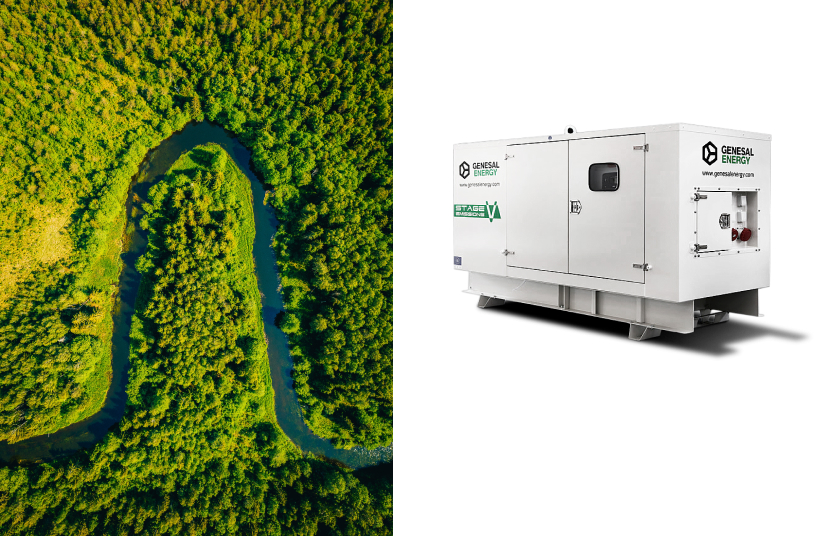From Regulation to Innovation: The Decarbonisation Pathway of Gensets

On the anniversary of the adoption of the Sustainable Development Goals, it is timely to review how strategic technologies such as gensets are being transformed to align with the 2030 Agenda. The transition towards a low-carbon economic model, reflected in goals such as SDG 7 (affordable and clean energy), SDG 9 (industry, innovation and infrastructure), SDG 12 (responsible consumption and production) and SDG 13 (climate action), is radically reshaping the framework in which distributed generation technologies operate. The increasing penetration of renewable sources such as wind and solar power adds complexity to the electricity system and raises resilience requirements. In this context, emergency gensets—traditionally regarded as marginal backup equipment—are becoming a critical element for energy security and operational continuity.
Decarbonisation of the sector must therefore be based on three main pillars: the gradual substitution of fossil diesel with renewable fuels, the development of hydrogen-based solutions, and the application of circular economy principles in design and manufacturing.
Their role is crucial in hospitals, data centres, telecommunications, transport and essential services, where they ensure supply in the event of grid failure. Although their annual operating time is limited—around ten hours on average in Europe, including periodic testing—and therefore their cumulative impact is small compared to other generation sources, achieving a climate-neutral economy aligned with the SDGs also requires these units to evolve. For this reason, the industry is working on the incorporation of renewable fuels, hydrogen-based solutions and ecodesign principles, so that gensets can maintain their strategic role while effectively reducing their environmental footprint.

Regulatory Framework: Stage V and the Outlook for Stage VI
Current EU legislation on emissions for internal combustion engines intended for non-road mobile machinery is mainly based on Regulation (EU) 2016/1628, known as Stage V. Its implementation, phased in between 2019 and 2021 depending on power ranges, broadened the spectrum of regulated capacities and substantially tightened the emission limits for NOx, particulates (PM), hydrocarbons (HC) and carbon monoxide (CO).
Stage V introduced the general requirement to use after-treatment technologies such as selective catalytic reduction (SCR), diesel oxidation catalysts (DOC) and diesel particulate filters (DPF). It also imposed the use of advanced electronic control systems, differential pressure sensors and emission monitoring through OBD (On-Board Diagnostics) in certain power ranges. For the mobile genset sector, this framework has entailed a comprehensive redesign of engines, combustion systems and control architectures, with a significant increase in technical complexity and production and maintenance costs.
On the anniversary of the Sustainable Development Goals, it is worth remembering that Europe’s energy transition requires massive electrification and deployment of renewables, but also resilience against intermittency and growing grid stress.
In parallel with the implementation of Stage V, the European Commission and sectoral bodies have opened the debate on a future Stage VI. This new phase is not conceived as a one-off adjustment but as the natural evolution of a regulatory framework aimed at supporting the decarbonisation of the European economy.
The outlook for Stage VI points to several areas of development:
- Application differentiation. A specific regulatory framework is being considered for emergency gensets (limited use, up to 200 hours per year) as opposed to continuous-use units.
- Real-world operating conditions. The introduction of tests reflecting in-field engine performance is under discussion, similar to RDE testing in the automotive sector.
- Compatibility with alternative fuels. Stage VI is expected to acknowledge the growing availability of advanced biofuels and the development of hydrogen applications, incorporating these vectors into compliance schemes.
Thus, the transition from Stage V to Stage VI will not only tighten emission limits but also redefine classification and approval procedures, forcing manufacturers and users to anticipate R&D investments and plan the technological transition of their fleets. This increasingly demanding framework should not be seen merely as a regulatory challenge, but as the catalyst for a broader transformation: the technological evolution of the sector towards a low-emission model. At this stage, the industry’s response goes beyond optimising after-treatment technologies and is directed towards effectively reducing the carbon footprint through renewable fuels, the development of hydrogen-based solutions, and the integration of ecodesign principles in the design and manufacture of equipment.

Sector Decarbonisation: Alternative Fuels, Hydrogen and Ecodesign
Decarbonisation of the sector must therefore be based on three main pillars: the gradual substitution of fossil diesel with renewable fuels, the development of hydrogen-based solutions, and the application of circular economy principles in design and manufacturing. Together, these provide a technological framework that enables emission reductions without compromising start-up reliability, ensuring supply availability in critical environments while anticipating future European regulatory demands.
Among the available solutions, advanced biofuels—particularly hydrotreated vegetable oil (HVO)—represent the most mature alternative for reducing the carbon footprint of both existing fleets and new units. HVO is a synthetic paraffinic fuel, compliant with EN 15940, that can be used in most modern diesel engines without technical modifications. It allows lifecycle CO₂ emission reductions of up to 90%, due to its biogenic origin, and offers additional advantages: it contains no sulphur or aromatics, provides cleaner combustion, delivers 10–18% lower emissions of particulates and NOx in tests, and has remarkable storage stability of up to ten years. From an operational standpoint, it integrates seamlessly into logistics without compromising start-up reliability in critical applications, making it the most immediate lever to advance decarbonisation.
The industry is working on the incorporation of renewable fuels, hydrogen-based solutions and ecodesign principles, so that gensets can maintain their strategic role while effectively reducing their environmental footprint.
Gas engines and dual-fuel applications offer an intermediate option in terms of reducing local emissions and diversifying energy sources. Their deployment, however, depends on the availability of supply infrastructure, which limits their use in applications where security of supply is critical. Even so, developments that enable operation with gas–diesel blends, or with hydrogen additions, open up new transitional pathways to cleaner solutions.
Looking further ahead, green hydrogen is emerging as the reference energy vector for the full decarbonisation of the sector. Pilot projects of gensets running entirely on hydrogen, as well as dual-fuel applications combining diesel and hydrogen, are already being validated by several European manufacturers. Although technical feasibility has been demonstrated, significant challenges remain in terms of production costs, engine durability, energy density and, above all, safe storage and distribution of the gas. In the medium term, hydrogen is considered a realistic solution in environments where it can be produced on-site by electrolysers coupled to renewable sources, as is already happening in certain industrial projects and strategic data centres.

Finally, ecodesign and the circular economy complete this strategy. More than 70% of a genset’s mass is currently recyclable thanks to the predominance of metals such as steel, copper and aluminium, and with improvements in design and manufacturing processes this figure can exceed 90%. Added to this is the long durability of these units: with proper maintenance, their service life can easily surpass three decades, allowing the impact of manufacturing to be amortised over a wide time horizon. In parallel, certifications such as ISO 14006 incorporate environmental criteria into the design phase, ensuring that products are conceived with a circular approach. Genesal Energy, the first company in the sector to obtain this certification, exemplifies how sustainability can be integrated into technological development strategies and deliver competitive advantages in markets with increasingly stringent environmental requirements.
When environmental performance is analysed from a lifecycle perspective, emergency gensets appear far more sustainable than often assumed. Their short operating times naturally limit cumulative emissions; the adoption of biofuels such as HVO drastically cuts their carbon footprint; and ecodesign maximises their circularity and efficiency. With these improvements, gensets reinforce their alignment with the EU’s circular economy objectives and consolidate an increasingly favourable environmental profile.
Conclusion
On the anniversary of the Sustainable Development Goals, it is worth remembering that Europe’s energy transition requires massive electrification and deployment of renewables, but also resilience against intermittency and growing grid stress. In this balance, gensets are irreplaceable: their limited operating time restricts environmental impact, while their role in ensuring the continuity of critical services is decisive.
Looking further ahead, green hydrogen is emerging as the reference energy vector for the full decarbonisation of the sector.
The Stage V framework has already marked a milestone in emission reduction, and the forthcoming Stage VI will pave the way for the integration of renewable fuels and hydrogen-based solutions, complemented by advances in biofuels such as HVO and in ecodesign.











